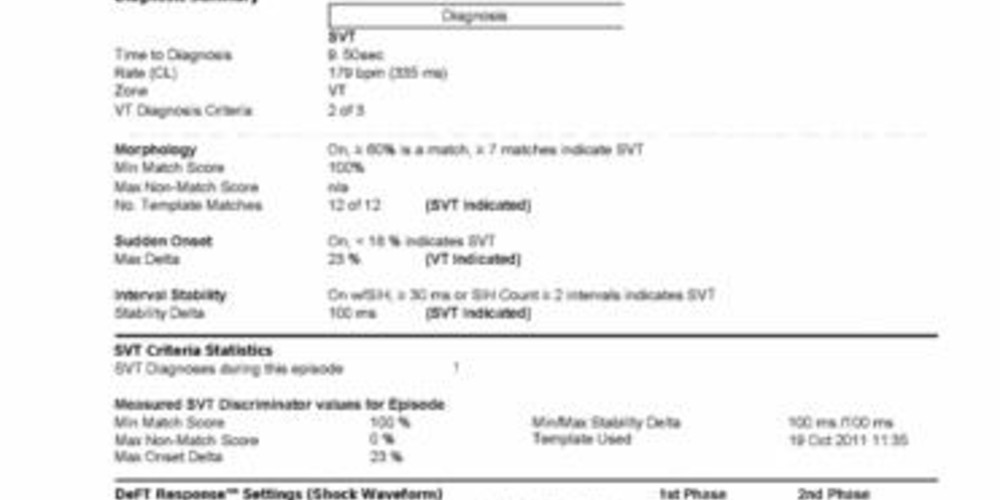Single chamber discrimination: atrial fibrillation
Tracing
Manufacturer Abbott
Device ICD
Field Discrimination
N° 41
Patient
This 73-year old recipient of a Abbott Fortify single chamber ICD implanted for hypertrophic cardiomyopathy, a history of aborted sudden cardiac death and episodes of paroxysmal atrial fibrillation (AF) were discovered on a routine follow-up.
Main programmed parameters
- VF zone at 222 bpm and VT zone at 171 bpm
- 8 cycles in the VF zone and 20 cycles in the VT zone were needed for the diagnosis
- Effective discrimination programmed in the VT zone
- VT diagnostic criteria: if 2 out of 3
- Morphology: ON (60%; 7 out of 12)
- Stability: ON 30 ms; detection window: 14 intervals
- SIH: passive, 2 intervals
- Sudden onset: ON, 18%

Graph and trace
Tracing
- irregular ventricular rhythm with alternations of cycles detected in the sinus zone (VS) and unclassified (-) cycles. The ventricular morphology is similar to that of the reference ventricular signal (100, ν);
- acceleration of the ventricular rate and shortening of the cycles in the VT zone (T);
- after 20 cycles classified T, the defibrillator renders its diagnosis; it is noteworthy that this tracing shows only 19 cycles classified as T. The EGM recording was limited to 14 sec before the diagnostic trigger. It is likely that the very first cycle fell just before the onset of this tracing. This event is key, as the analysis of sudden onset hinges on this pivotal initial cycle, which, in this particular instance cannot be verified. The stability delta is measured at 100 ms; this printed record misses the 2 cycles that occurred, respectively, at the onset and at the end of the line. They could, however, be viewed on the programmer. The longest out of the 12 cycles preceding the diagnosis measured 402 ms, and the second longest 395 ms. The shortest measured 289 ms and the second shortest 293 ms, corresponding to a 395 minus 293 ms = 102 ms delta (rounded down to 100 ms in the text), an outcome in favor of SVT. Since the rhythm was classified as unstable, the SIH parameter was not analyzed. The morphology criterion was also in favor of SVT: the number of similar ventricular complexes being 12 out of 12, the diagnosis was SVT (100, ν); and therapy was not delivered;
- slowing of the ventricular rate and diagnosis of return to sinus rhythm after 3 VS without intervening T cycle.
Other articles that may be of interest to you







This was an episode of AF accurately diagnosed by the device. In AF, at least 2 to 3 criteria typically indicate SVT. It may begin suddenly (VT), the rhythm is unstable (SVT) and morphology remains unchanged (SVT). Therefore, the recommended programming of 2 out of 3 parameters discriminates reliably. In contrast, the programming of a single out of 3 criteria may be associated with the delivery of inappropriate therapies.
The stability criterion (defined by the widest difference between the second longest and second shortest cycles among 12 consecutive cycles preceding the tachycardia detection) can be misleading in special cases and might produce an erroneous diagnosis in patients in AF, whose ventricular rate is >170 bpm with a mostly stable rhythm.
The stability of tachycardia does not, by itself, always distinguish VT from AF accurately, such that it may be useful to add the SIH criterion, which operates in association with rate stability (programmed on: ON + SIH), and only in single chamber devices. This function, which intervenes only when the ventricular rate is sensed as stable, may be useful to detect “regularized” AF with long cycles.